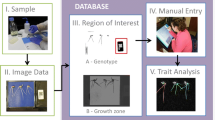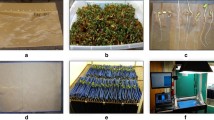Abstract
The objective of this study was to develop a phenotyping platform for the non-destructive, digital measurement of early root growth of axile and lateral roots and to evaluate its suitability for identifying maize (Zea mays L.) genotypes with contrasting root development. The system was designed to capture images of the root system within minutes and to batch process them automatically. For system establishment, roots of the inbred line Ac7729/TZSRW were grown until nine days after germination on the surface of a blotting paper in pouches. An A4 scanner was used for image acquisition followed by digital image analysis. Image processing was optimized to enhance the separation between the roots and the background and to remove image noise. Based on the root length in diameter-class distribution (RLDD), small-diameter lateral roots and large-diameter axile roots were separated. Root systems were scanned daily to model the growth dynamics of these root types. While the axile roots exhibited an almost linear growth, total lateral root length increased exponentially. Given the determined exponential growth, it was demonstrated that two plants, germinated one day apart but with the same growth rates differed in root length by 100%. From the growth rates we were able to identify contrasting genotypes from 236 recombinant inbred lines (RILs) of the CML444 x SC-Malawi cross. Differences in the growth of lateral roots of two selected RILs were due to differences in the final length and linear density of the primary lateral roots, as proven by the manual reanalysis of the digital images. The high throughput makes the phenotyping platform attractive for routine genetic studies and other screening purposes.










Similar content being viewed by others
Abbreviations
- CMYK:
-
cyan, magenta, yellow and key (black)
- DAG:
-
days after germination
- ERAx :
-
elongation rate of axile roots
- HSV:
-
hue, saturation, value
- kLat :
-
relative elongation rate of lateral roots
- QTLs:
-
quantitative trait loci
- RGB:
-
red, green, blue
- RIL:
-
recombinant inbred line
- RLDD:
-
ziameter-class distribution
References
Bonser AM, Lynch J, Snapp S (1996) Effect of phosphorus deficiency on growth angle of basal roots in Phaseolus vulgaris. New Phytol 132:281–288. doi:10.1111/j.1469-8137.1996.tb01847.x
Bourdu R, Grégory N (1983) Etude comparée du début de la croissance chez divers génotypes de maïs. Agronomie 3:761–770. doi:10.1051/agro:19830807
Chassot A, Richner W (2002) Root characteristics and phosphorus uptake of maize seedlings in a bilayered soil. Agron J 94:118–127
Cooper CS, Mac Donald PW (1970) Energetics of early seeling growth in corn (Zea mays L.). Crop Sci 10:136–139
Delées E, Grégory N, Bourdu R (1984) Transition between seed reserves use and photosynthetic supply during development of maize seedlings. Plant Sci Lett 37:35–39. doi:10.1016/0304-4211(84)90199-8
Doussan C, Pierret A, Garrigues E, Pages L (2006) Water uptake by plant roots: II—Modelling of water transfer in the soil root-system with explicit account of flow within the root system—Comparison with experiments. Plant Soil 283:99–117. doi:10.1007/s11104-004-7904-z
Enns LC, McCully ME, Canny MJ (2006) Branch roots of young maize seedlings, their production, growth, and phloem supply from the primary root. Funct Plant Biol 33:391–399. doi:10.1071/FP06029
Gregory PJ, Hutchison DJ, Read DB, Jenneson PM, Gilboy WB, Morton EJ (2003) Non-invasive imaging of roots with high resolution X-ray micro-tomography. Plant Soil 255:351–359. doi:10.1023/A:1026179919689
Hoecker N, Keller B, Piepho HP, Hochholdinger F (2006) Manifestation of heterosis during early maize (Zea mays L.) root development. Theor Appl Genet 112:421–429. doi:10.1007/s00122-005-0139-4
Hund A, Frachboud Y, Soldati A, Frascaroli E, Salvi S, Stamp P (2004) QTL controlling root and shoot traits of maize seedlings under cold stress. Theor Appl Genet 109:618–629. doi:10.1007/s00122-004-1665-1
Hund A, Richner W, Soldati A, Fracheboud Y, Stamp P (2007) Root morphology and photosynthetic performance of maize inbred lines at low temperature. Eur J Agron 27:52–61. doi:10.1016/j.eja.2007.01.003
Hund A, Fracheboud Y, Soldati A, Stamp P (2008a) Cold tolerance of maize seedlings as determined by root morphology and photosynthetic traits. Eur J Agron 28:178–185. doi:10.1016/j.eja.2007.07.003
Hund A, Ruta N, Liedgens M (2008b) Rooting depth and water use efficiency of tropical maize inbred lines, differing in drought tolerance. Plant Soil (in press). doi:10.1007/s11104-008-9843-6
Janssen GJW, VanNorel A, VerkerkBakker B, Janssen R (1995) Detecting resistance to the root-knot nematodes Meloidogyne hapla and M-chitwoodi in potato and wild Solanum spp. Potato Research 38:353–362
Lambers H, Shane MW, Cramer MD, Pearse SJ, Veneklaas EJ (2006) Root structure and functioning for efficient acquisition of phosphorus: Matching morphological and physiological traits. Ann Bot (Lond) 98:693–713. doi:10.1093/aob/mcl114
Liao H, Rubio G, Yan XL, Cao AQ, Brown KM, Lynch JP (2001) Effect of phosphorus availability on basal root shallowness in common bean. Plant Soil 232:69–79. doi:10.1023/A:1010381919003
Liao H, Yan XL, Rubio G, Beebe SE, Blair MW, Lynch JP (2004) Genetic mapping of basal root gravitropism and phosphorus acquisition efficiency in common bean. Funct Plant Biol 31:959–970. doi:10.1071/FP03255
Liu JC, Li JS, Chen FJ, Zhang FS, Ren TH, Zhuang ZJ, Mi GH (2008) Mapping QTLs for root traits under different nitrate levels at the seedling stage in maize (Zea mays L.). Plant Soil 305:253–265. doi:10.1007/s11104-008-9562-z
Manschadi AM, Christopher J, Devoil P, Hammer GL (2006) The role of root architectural traits in adaptation of wheat to water-limited environments. Funct Plant Biol 33:823–837. doi:10.1071/FP06055
Manschadi AM, Hammer GL, Christopher JT, deVoil P (2008) Genotypic variation in seedling root architectural traits and implications for drought adaptation in wheat (Triticum aestivum L.). Plant Soil 303:115–129. doi:10.1007/s11104-007-9492-1
McCully ME (1999) Roots in soil: unearthing the complexities of roots and their rhizospheres. Annu Rev Plant Physiol Plant Mol Biol 50:695–718. doi:10.1146/annurev.arplant.50.1.695
McMichael BL, Burke JJ (1998) Soil temperature and root growth. HortScience 33:947–951
Messmer R (2006) The genetic dissection of key factors involved in the drought tolerance of tropical maize (Zea mays L.). Diss. ETH No. 16695., Zurich, Switzerland. http://e-collection.ethbib.ethz.ch/show?type=diss&nr=16695
Pinheiro J, Bates D, DebRoy S, Sarkar D (2004) nlme: Linear and nonlinear mixed effects models. R package version 3.
R Development Core Team (2008) R: A language and environment for statistical computing. R Foundation for Statistical Computing, Vienna, Austria
Richner W, Liedgens M, Bürgi H, Soldati A, Stamp P (2000) In root methods. A handbook. In Smit A, Bengough A, Engels C, Van Noordwijk M, Pellerin S (Eds) A handbook. pp 305–342. Springer
Roumet C, Lafont F, Sari M, Warembourg F, Garnier E (2008) Root traits and taxonomic affiliation of nine herbaceous species grown in glasshouse conditions. Plant Soil 312:69–83. doi:10.1007/s11104-008-9635-z
Thain T (2005) “Histotext”, a filter plugin for Adobe Photoshop. http://www.telegraphics.com.au/sw/#histotext.
Tuberosa R, Sanguineti MC, Landi P, Giuliani MM, Salvi S, Conti S (2002) Identification of QTLs for root characteristics in maize grown in hydroponics and analysis of their overlap with QTLs for grain yield in the field at two water regimes. Plant Mol Biol 48:697–712. doi:10.1023/A:1014897607670
Varney GT, Canny MJ (1993) Rates of water-uptake into the mature root-system of maize plants. New Phytol 123:775–786. doi:10.1111/j.1469-8137.1993.tb03789.x
Varney GT, Canny MJ, Wang XL, McCully ME (1991) The branch roots of Zea. 1. 1st order branches, their number, sizes and division into classes. Ann Bot (Lond) 67:357–364
Walter A, Spies H, Terjung S, Kusters R, Kirchgessner N, Schurr U (2002) Spatio-temporal dynamics of expansion growth in roots: automatic quantification of diurnal course and temperature response by digital image sequence processing. J Exp Bot 53:689–698. doi:10.1093/jexbot/53.369.689
Weaver JE (1925) Investigations on the root habits of plants. Am J Bot 12:502–509. doi:10.2307/2435298
Zhu JM, Kaeppler SM, Lynch JP (2005) Mapping of QTLs for lateral root branching and length in maize (Zea mays L.) under differential phosphorus supply. Theor Appl Genet 111:688–695. doi:10.1007/s00122-005-2051-3
Zobel R (2003) Sensitivity analysis of computer-based diameter measurement from digital images. Crop Sci 43:583–591
Zobel RW (2008) Hardware and software efficacy in assessment of fine root diameter distributions. Comput Electron Agric 60:178–189. doi:10.1016/j.compag.2007.08.002
Zobel RW, Kinraide TB, Baligar VC (2007) Fine root diameters can change in response to changes in nutrient concentrations. Plant Soil 297:243–254. doi:10.1007/s11104-007-9341-2
Acknowledgements
The authors would like to thank Susanne Hochmann for her technical assistance, Jann Röder for the programming of the scanning software, Dr. Yunbi Xu for supplying the genotypes, Dr. Markus Liedgens for his support with the statistics and the anonymous reviewers for their valuable comments. This study was supported by the Generation Challenge Programme (Project 15).
Author information
Authors and Affiliations
Corresponding author
Additional information
Responsible Editor: Peter J. Gregory.
Rights and permissions
About this article
Cite this article
Hund, A., Trachsel, S. & Stamp, P. Growth of axile and lateral roots of maize: I development of a phenotying platform. Plant Soil 325, 335–349 (2009). https://doi.org/10.1007/s11104-009-9984-2
Received:
Accepted:
Published:
Issue Date:
DOI: https://doi.org/10.1007/s11104-009-9984-2




